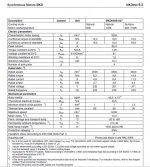Hello,
I’m having difficulties understanding a data sheet that I have for an Indramat servo motor. I’m working on trying to find some typical ratings that don’t seem to be very straight forward from the motor’s datasheet/nameplate. If you refer to the attached image, I have a few questions:
-Near the top, there is a cooling mode section which (I believe) separates the motor model into 3 sub categories. However, what do the descriptions of Natural 60K and Natural 100K mean? What are these numbers and what is the K represent?
-The characteristic motor speed. I would have expected this to be in RPM, but the units are simply min-1. Does this represent per minutes? What per minute? RPM?
-Right below that, the continuous torque at standstill has values that are provided. But why are there two numbers in a single box? Why is there 12,0? Is the comma meant to represent a decimal point?
I realize this isn’t exactly a PLC question, but the overall project I’m working on is implementing a new PLC which needs to interact with a new motor replacement. Thank you

I’m having difficulties understanding a data sheet that I have for an Indramat servo motor. I’m working on trying to find some typical ratings that don’t seem to be very straight forward from the motor’s datasheet/nameplate. If you refer to the attached image, I have a few questions:
-Near the top, there is a cooling mode section which (I believe) separates the motor model into 3 sub categories. However, what do the descriptions of Natural 60K and Natural 100K mean? What are these numbers and what is the K represent?
-The characteristic motor speed. I would have expected this to be in RPM, but the units are simply min-1. Does this represent per minutes? What per minute? RPM?
-Right below that, the continuous torque at standstill has values that are provided. But why are there two numbers in a single box? Why is there 12,0? Is the comma meant to represent a decimal point?
I realize this isn’t exactly a PLC question, but the overall project I’m working on is implementing a new PLC which needs to interact with a new motor replacement. Thank you





